Abstract
In this study, the effect of carbon nanotubes (CNTs) on the physical properties of cement composites was investigated. The mechanism of the change of autogenous shrinkage of CNTs-reinforced cement composites was also examined. In the experiments, ordinary Portland cement (OPC) and fly ash (FA) were used as binders, and 0.0, 0.1, 0.3, and 0.5% multi-walled CNTs (MWCNTs) were added to fabricate pastes. When the hydration heat was measured through isothermal calorimetry, it was found that CNTs accelerated the early age hydration of the pastes and that the hydration rate increased as the CNT content increased. The compressive strength was the highest when the CNT content was 0.1%. As the CNT content increased, the internal relative humidity (IRH) decreased and autogenous shrinkage showed a decreasing tendency. Through the analysis of the correlation between autogenous shrinkage and IRH, it was confirmed that the reduction in autogenous shrinkage due to the addition of CNTs resulted from the decrease in bulk strain.
1. Introduction
Carbon nanotubes (CNTs) are widely used owing to their mechanical, electrical, and thermal properties [1,2,3]. The electrical conductivity of CNTs is similar to that of metallic materials. Their yield strength ranges from 10 to 60 GPa, and their modulus of elasticity ranges from 0.3 to 1 TPa [4,5]. Mixed with other materials, CNTs make it possible to create conducting pathways in composites even with a low content as they have high aspect ratios (between 10 and 1000) [6].
Several studies have also been conducted in the field of construction to apply CNTs to cement composites [7]. Previous studies focused on the effects of CNTs on the mechanical properties of cement composites, such as compressive, flexural, and tensile strengths [7,8,9,10,11]. In addition, a few other studies have been conducted on the heating and self-sensing properties of cement composites using the electromagnetic properties of CNTs [5,12,13,14,15,16,17]. To use CNT-reinforced cement composites in the field, their hydration and shrinkage properties need to be investigated; several researchers have conducted studies on such properties.
Makar and Chan [18] reported that CNTs accelerate the early age hydration of cement, which is related to the nucleation effect of CNTs. They also reported that CNTs form homogeneous networks inside cement composites as fillers and that they play the role of an entangled mesh that supports hydration products. Petrunin et al. [19] evaluated the interaction between CNTs and hydrate ions and explained the interaction between Ca2+ and CNTs based on the binding mechanism. They also experimentally revealed that the C-S-H gel concentration was increased by CNTs [19]. Yamamoto et al. [20] reported that CNTs improve the toughness of cement composites as they serve as bridges between hydration products. Konsta-Gdoutos et al. [21] reported that CNTs accelerate the generation of C-S-H or CH by providing nucleation sites with respect to cement hydration. Raza et al. [22] investigated the mechanical properties of CNT-reinforced cement composites. They reported that CNTs improve the mechanical properties of cement composites because the microstructure of CNTs-reinforced cement composites become denser than normal cement composites.
To improve the self-heating performance of CNT-reinforced cement composites, the homogeneity of the conducting pathways formed by CNTs inside the matrix must be ensured. Adding aggregate into the matrix interferes with the interconnectivity of CNTs and has an adverse effect on the conductive network, thereby increasing the electrical resistance [23]. In addition, cement composites with a low water-to-binder ratio increase the dispersibility of CNTs, thereby improving the electrical conductivity [24,25]. Therefore, high-strength cement paste with a low water-to-cement (W/C) ratio is likely to be subjected to cracking at early ages due to the occurrence of high autogenous shrinkage [26,27]. Stynoski et al. [28] reported that the induction period decreased and the heat flow increased when 0.25% CNT was added compared to the cement weight. The authors also reported that CNTs accelerated the hydration of cement by affecting the nucleation of C-S-H and improving water availability around the CNTs. The accelerated cement hydration may increase the autogenous shrinkage. However, CNTs play the role of an entangled mesh that supports hydration products by forming homogeneous networks inside cement composites as fillers [18]. This increases the resistance to autogenous shrinkage by increasing the stiffness between the hydration products [29,30]. Liu et al. [31] investigated effect of CNTs on early autogenous shrinkage of cement paste. They also reported that the early autogenous shrinkage of cement paste decreased by adding CNTs because CNTs accelerated the hydration of cement composites.
As mentioned above, many studies have been conducted on multifunctional concrete such as self-sensing concrete in which CNTs are applied to concrete. CNTs are not used for the purpose of changing the physical properties of concrete, but CNTs affect the properties of concrete such as hydration, strength, and shrinkage. Therefore, the effect of CNTs on the properties of concrete should be investigated to use CNTs for making multifunctional concrete. A literature review revealed that CNTs accelerate the hydration reaction of cement particles and reinforce matrices such as steel fibers and synthetic fibers when used as fillers for cement materials. This indicates that CNTs have a significant influence on the volumetric properties of cement, such as autogenous shrinkage as well as its mechanical properties. These must be examined to effectively use CNTs as construction materials, but the related research is insufficient. Several studies have investigated the mechanism of CNTs on the mechanical properties and hydration of cement composites. However, studies investigating the mechanism of autogenous shrinkage of CNT-reinforced cement composites are still lacking. The purpose of this study is to investigate the mechanism by which autogenous shrinkage is changed by CNTs.
In this study, the effect of the CNT content on the hydration and autogenous shrinkage of cement composites was investigated. To this end, CNT-reinforced cement composites were fabricated using ordinary Portland cement (OPC) and fly ash (FA) as binders and adding 0.0, 0.1, 0.3, and 0.5% multi-walled CNTs (MWCNTs). The hydration characteristics of CNT-reinforced cement composites were investigated by analyzing the setting, heat of hydration, and scanning electron microscopy (SEM) images. In addition, experiments were performed to investigate the autogenous shrinkage and internal relative humidity (IRH). Through the experiments, the effect of CNTs on the autogenous shrinkage of cement composites was investigated.
2. Materials and Experiments
2.1. Materials
In this study, OPC and FA were used as binders to fabricate CNT-reinforced cement composites. Table 1 shows the chemical compositions of OPC and FA by X-ray fluorescence (XRF) analysis (ZSX Primus II, Rigaku, Tokyo, Japan). The densities of OPC and FA were 3.14 and 2.30 g/cm3, respectively. For FA, the refined FA produced at thermal power plant Y in South Korea was used. The contents of CaO and SiO2 + Al2O3 + Fe2O3 in FA were 3.93% and 84.76%, respectively, which corresponded to class F according to ASTM C 618. SEM images shown in Figure 1 were obtained using an ultra-high-resolution cold field-emission SEM (Hitachi SU-8230, Hitachi, Japan). Figure 1a shows the morphology of the FA observed using SEM. FA was found to be spherical. The CNTs used in this study were MWCNTs with an average diameter of 10 nm and an average length of 1.5 μm. Figure 1b shows the SEM images of the CNTs used. To use CNTs in cement-based materials, the dispersion problem must be solved. As with powdered cement materials, CNT particles are aggregated during mixing owing to the application of the Van der Waals force. To prevent CNT aggregation, CNTs were prepared in the form of an aqueous solution. To improve dispersibility, an aqueous solution of 5% polycarboxylate-based superplasticizer was prepared [32]. The solid content of the CNT added to the aqueous solution was 2.01% by weight. And CNTs in solution were dispersed through sonication for 2 h.

Table 1.
Chemical compositions of OPC and FA.
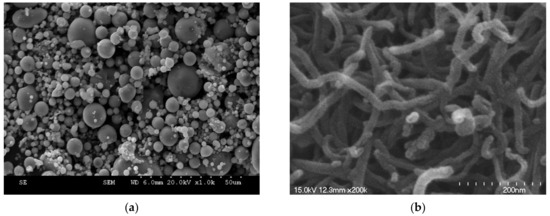
Figure 1.
SEM images of raw materials: (a) FA; (b) CNTs.
Figure 2 shows the thermogravimetric (TG) and differential thermogravimetric (DTG) curves of the CNTs. Multiple peaks were observed in the graph, indicating that multiple components such as nanotubes, amorphous carbon, and graphitic nanoparticles were present inside the CNTs [33]. The largest weight change occurred between 350 and 500 °C, and the residue content was found to be 50% after 500 °C. During the production of CNTs, the section in which the weight change occurs varies with the production method used and the proportion of raw materials [34,35].
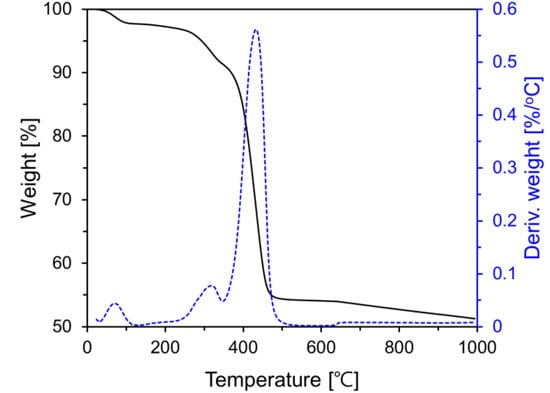
Figure 2.
TG/DTG measurements of CNT.
Figure 3 shows the particle size distributions (PSDs) of OPC and FA. The PSDs of the raw materials were measured by laser diffraction analysis (Beckman Coulter LS 230). OPC showed a monomodal distribution, while FA exhibited a bimodal distribution.
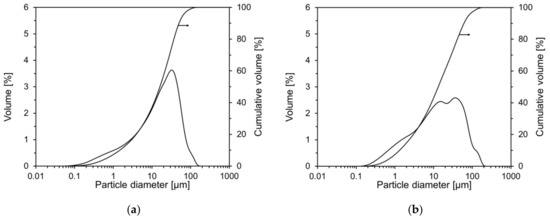
Figure 3.
Measured PSDs of raw materials: (a) OPC; (b) FA.
2.2. Mix Proportions
Table 2 shows the mix proportions used to fabricate the CNT-reinforced cement paste. The main parameter was the CNT content, which was varied as 0.0, 0.1, 0.3, and 0.5% of the binder weight. For all specimens, the W/C ratio was fixed at 0.28, and 20% FA compared to the cement weight was added to improve the workability of the paste and the dispersibility of the CNTs [36,37,38]. The amount of water listed in Table 2 is considered as the total amount of water contained in the CNT solution. For the mix proportions shown in Table 2, cement and FA were mixed first using a forced mixer for 30s. An aqueous solution in which water and CNTs were mixed was then added, and wet mixing was performed for approximately 6 min.

Table 2.
Mixture proportions of CNT-reinforced cementitious composites.
2.3. Test Methods
The setting time of the CNT paste was measured in a constant temperature and humidity chamber (23 °C and 50%) using a Vicat device in accordance with ASTM C191 [39].
The compressive strength of the CNT paste was measured at 28 days in accordance with ISO 679 [40]. For each mixture in Table 2, three specimens were fabricated using a 40 × 40 × 160 mm metal mold. The paste specimens were cured in a constant temperature and humidity chamber at 20 ± 1 °C and a relative humidity of 90% or higher for 24 h. They were then removed from the mold and cured in a water tank at 20 ± 1 °C until 28 days of age. Each specimen was split into two before measuring the compressive strength. The compressive strengths of six specimens were measured, and the average value was used.
For the CNT paste, the heat flow of hydration and cumulative heat were measured using a TAM Air isothermal calorimeter in the same way as in the experiment conducted by Park and Choi [41]. The TAM Air 8-channel standard volumetric calorimeter operates in the mW range and consists of an 8-channel twin-type calorimeter block and a data acquisition system. After each mixture was homogeneously mixed, approximately 4 g of paste was placed in a 20 mL glass ampoule and the weight was measured. The glass ampoule was installed in a calorimeter maintained at 23 °C and measured for 48 h. Figure 4 shows the TAM Air isothermal calorimeter used in this study.
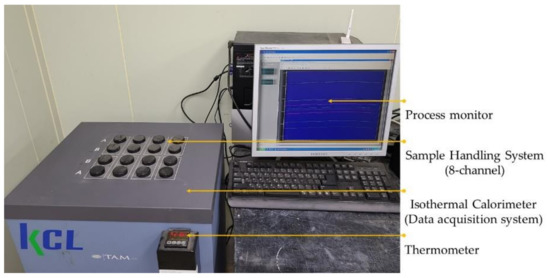
Figure 4.
TAM Air isothermal calorimeter.
The autogenous shrinkage of CNT-reinforced cement composites was measured using a gauge embedded in the center of the specimen, which was placed in a 50 × 50 × 300 mm beam mold sealed with Teflon and polyester sheets, as shown in Figure 5. Three specimens were used to measure autogenous shrinkage for each variable. This test method was similar to that reported by Kohno et al. [42] and Kim et al. [43]. The PMFL-series embedded strain gauges with a length of 60 mm and a diameter of 4 mm (Tokyo Sokki Kenkyujo Co., Ltd., Japan), showing the applicability in measuring the autogenous shrinkage inside CNT-reinforced cement composites, were pre-located inside the mold in this test. Teflon sheets were used inside the mold to minimize the stress that may occur during the early hardening process. In addition, buffer sponges were installed at both ends of the mold to minimize the restriction of the specimen at both ends. The top surface of the specimen was sealed using aluminum foil tape to prevent moisture evaporation. In this test, autogenous shrinkage was measured while the specimen was placed inside the mold without demolding. Autogenous shrinkage was measured in a constant temperature and humidity chamber at a temperature of 23 ± 2 °C and a relative humidity of 60 ± 10% every 5 min using a data logger. The autogenous shrinkage result was calculated based on the final setting time (See Table 3).

Figure 5.
Test method for autogenous shrinkage measurement: (a) Diagram of test setup; (b) The overview of autogenous shrinkage measurement.

Table 3.
Setting times of CNT-reinforced cement composites.
The relative humidity inside the CNT-reinforced cementitious composites was measured using the setup shown in Figure 6. Approximately two-thirds of the disposable cylindrical sample cup (diameter of 45 mm and height of 40 mm) was filled with the specimen to be measured. A temperature humidity probe (HC2-AW-USB, Switzerland, Rotronic AG) was then fixed on top of the sample holder containing the sample cup. These were mechanically fixed by the clamp sealing apparatus during the test to minimize the influence of the surrounding environment. The measured relative humidity was automatically recorded in a connected computer every 5 min. For each mixture, the RH values of the three specimens were measured and the average value was used.
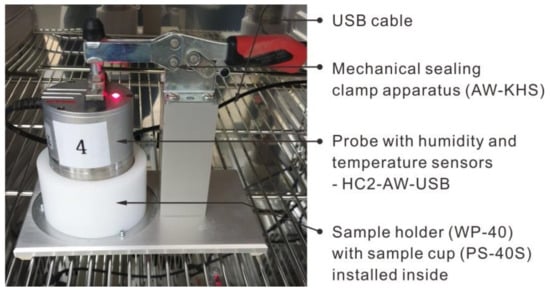
Figure 6.
Test setup for measurement of IRH.
To analyze the morphology of the CNTs and CNT-reinforced cement composites, SEM images were obtained using an ultra-high-resolution cold field-emission SEM (Hitachi SU-8230, Hitachi, Japan). The specimen was crushed into particles of less than 5 mm after the 28-day compressive strength test to observe SEM images of CNT-reinforced cement composites. The crushed samples were dried at 40 °C for 24 h [44].
The phase compositions of the CNTs and CNT-reinforced cement composites were investigated through TG/DTG. Thermo Plus EVO II by Rigaku was used as the TG/DTG analyzer. The specimens for TG/DTG analysis were crushed using a hand pestle at 28 days. The crushed specimens were sifted through a 75 μm sieve to prepare samples. The TG/DTG analysis of the samples was conducted in a nitrogen environment (300 mL/min) at room temperature using an alumina pan. The temperature was increased from room temperature to 1000 °C at a heating rate of 10 °C/min.
3. Results and Discussion
3.1. Hydration
In this study, the setting time and initial heat of hydration were measured to investigate the initial hydration characteristics of CNT-reinforced cement composites. Table 3 shows the setting times of CNT-reinforced cement composites. The setting times decreased as the CNT content increased. When the CNT content increased to 0.5%, the initial setting time was reduced by 6 min and the final setting time by 10 min. The initial setting and final setting were accelerated by 2.4% and 3.0%, respectively, compared to CRC00. Although the reduced time was short, the setting times decreased in proportion to the CNT content.
Figure 7 shows the heat flow and cumulative heat releases of CNT-reinforced cement composites. In general, the hydration of OPC is divided into four periods: the initial period, induction period, acceleration period, and retardation period [45]. As shown in Figure 7a, the heat flow was not changed in the induction period regardless of the CNT content. As the CNT content increased, the acceleration period quickened, and the peak increased. In addition, the retardation period also decreased as the CNT content increased. This indicates that the addition of CNTs accelerated the hydration reaction of cementitious materials because the mix proportions except for the CNT content were the same in this study. This result was also reported by other researchers [18,28]. The authors estimated that the CNTs inside the paste accelerated the hydration of OPC because it acted as nucleating agents [18,28]. As the CNT content increased, the hydration reaction of cement accelerated, and the 48-h cumulative heat increased (see Figure 7b). In the case of CRC01, its cumulative heat was higher than that of CRCC00 after 12 h; however, its 48-h cumulative heat was the same as that of CRC00. Therefore, the cumulative heat of CRC00 is likely to be higher than that of CRC01 after 48 h. As the amount of binders and water used in each specimen were the same, it was found that the addition of CNTs can accelerate the hydration reaction; however, the cumulative heat may decrease with the increase in CNT content. Tafesse and Kim [46] investigated the hydration kinetics of CNT-reinforced pastes with a W/C ratio of 0.4. They reported that the 60-h cumulative heat of a specimen with a CNT content of 0.6% compared to the binder was lower than that of a specimen with a CNT content of 0.3%, even though the addition of CNTs accelerated the hydration reaction.
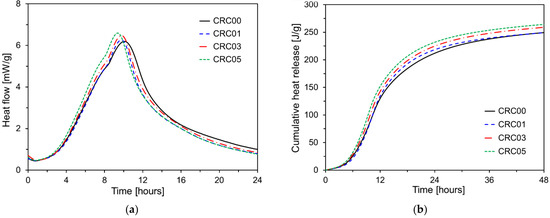
Figure 7.
The heat flow and cumulative heat releases of CNT-reinforced cement composites: (a) Heat flow; (b) Cumulative heat release.
3.2. Compressive Strength
Figure 8 shows the compressive strength of CNT-reinforced cementitious composites at 28 days. CRC01 exhibited the highest compressive strength in the graph, and the compressive strength decreased as the CNT content increased. CNTs were expected to increase the early age strength because they act as nucleating agents and accelerate early age hydration, but the strength was found to decrease as the CNT content increased. Jung et al. [47] reported that the strength increased and then decreased as the CNT content increased. As a result, they suggested suppressing hydration, agglomerating CNT, and increasing air voids due to the excessive supply of CNTs. The porosity measurement results confirmed that entrained and entrapped air voids increased when the CNT content increased. Guan et al. [48] also reported that compressive strength is highest when the addition of CNTs is 0.1% (binder wt.%) among 0.0~0.2% CNTs-reinforced cement composites. Figure 9 shows the agglomerated CNT in CRC05. When CNTs are agglomerated, as shown in the figure, they act as a vulnerable cross-section and decrease the strength. Therefore, it is important to disperse CNTs so that they cannot be agglomerated to improve their mechanical properties through the addition of CNTs.

Figure 8.
The compressive strength of CNT-reinforced cement composites.
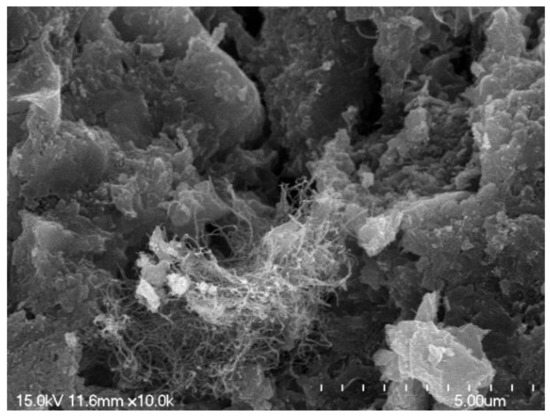
Figure 9.
Agglomerated CNT in CRC05.
3.3. Autogenous Shrinkage
Figure 10a shows the autogenous shrinkage during 24 h. In the graph, the y-axis represents the autogenous strain after the final setting. As shown in the figure, the specimens expanded before 4 h. Several researchers have reported that specimens expanded at early ages due to the generation of ettringite [49,50,51]. The expansion rate increased as the CNT content increased. As shown in Figure 7a, the acceleration period accelerated as the CNT content increased. This also appears to have increased the expansion rate because hydration was accelerated before 4 h. After 4 h, the specimens were contracted by autogenous shrinkage.

Figure 10.
Autogenous shrinkage of CNT-reinforced cement composites: (a) 24 h; (b) 168 h.
Figure 10b shows the autogenous shrinkage during 168 h. The autogenous shrinkage decreased as the CNT content increased. Autogenous shrinkage is caused by self-desiccation, which occurs when the water in capillary pores is reduced as it is used for the hydration of cement. Therefore, a decrease in autogenous shrinkage means that more water is left in the capillary pores [42]. It was expected that the addition of CNTs would increase autogenous shrinkage due to the accelerated hydration caused by the nucleation effect of CNTs, but the experimental results were found to be opposite. CNTs bridge adjacent hydrates because they have a long geometry, as shown in Figure 1b [47,52]. This phenomenon is referred to as the bridge effect, and it can also be observed in the SEM images of a CNT-reinforced cement composite in Figure 11 [47]. The bridge effect of CNTs is known to improve the mechanical performance of cementitious materials, such as strength [47]. Therefore, the bridge effect of CNTs appears to have decreased autogenous shrinkage even though the hydration of OPC was accelerated by them.
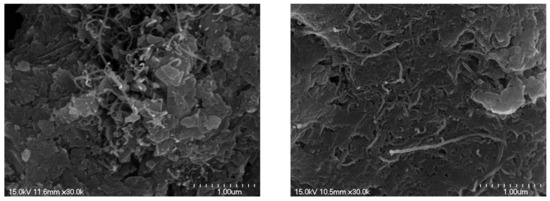
Figure 11.
SEM images of CRC05.
Many studies have been conducted to investigate the autogenous shrinkage of CNT-reinforced cement composites, but various results have been reported depending on the experimental conditions. Kim et al. [53] reported that the autogenous shrinkage of paste with silica fume (SF) increased when CNTs were added. Tafesse and Kim [46] reported that the addition of CNTs increased autogenous shrinkage at a W/C ratio of 0.25, but it decreased deformation at a W/C ratio of 0.4. Song et al. [54] investigated autogenous shrinkage according to the substitution rate of SF and the CNT content, and reported that the CNT content to minimize autogenous shrinkage was different depending on the substitution rate of SF.
Figure 12 shows the IRH of the CNT-reinforced cement composites. IRH began to decrease after 24 h, and IRH decreased more rapidly as the CNT content increased. For CRC05, IRH decreased after approximately 12 h. The time at which IRH began to decrease was delayed as the CNT content decreased. Figure 7 also shows that hydration was accelerated as the CNT content increased, indicating that the decrease in IRH was also accelerated due to the acceleration of hydration. CRC01 and CRC03 exhibited similar IRH values until 48 h, but the IRH of CRC03 was lower than that of CRC01 after 48 h. The difference in IRH between CRC00 and CRC05 was the largest at 36 h. The difference was maintained from 36 to 144 h, but it decreased after 144 h. This indicates that the addition of CNTs accelerates the water reduction rate inside the pores due to the increase in the initial hydration rate, but its influence decreases after 144 h. The IRH of CRC05 was lower than that of CRC03 until 144 h, but they became identical after 144 h. This indicates that the effect of CNT addition on IRH decreases as age increases. This tendency was also observed in Figure 7. The cumulative heat release of CRC01 was higher than that of CRC00 at early ages, but they became similar at 48 h. The difference in cumulative heat release between CRC05 and CRC03 also increased after four h, but it decreased after 48 h. CRC05 exhibited the highest hydration rate due to the shortest induction period, and it also showed the fastest reduction in IRH.
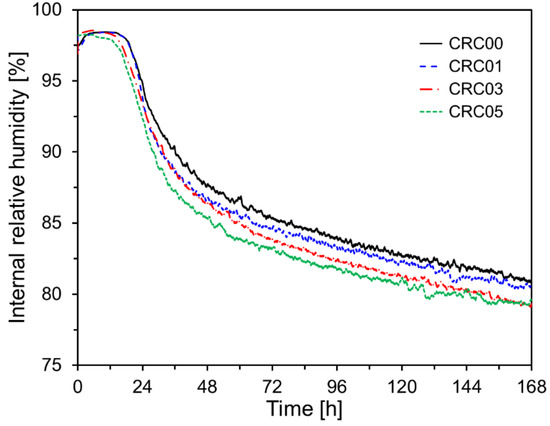
Figure 12.
IRH of CNT-reinforced cement composites.
Figure 13 shows the relationship between the autogenous shrinkage and IRH. The graph is divided into two stages. In the first stage, autogenous shrinkage increased with no change in RH, which is referred to as the water-vapor saturated stage. The water-vapor saturated stage was also observed in other studies, and it is affected by the water-to-binder ratio [54,55,56]. In the second stage, the RH decreased. In stage I, the CRC00 sample exhibited the largest autogenous shrinkage, and autogenous shrinkage decreased as the CNT content increased. In stage I, the shrinkage increased due to the change in bulk strain, regardless of the hydration reaction. It appears that the bulk strain decreased as the CNT content increased, owing to the bridge effect of the CNTs. In stage II, the change in autogenous shrinkage was similar regardless of the CNT content. The slope of stage II is affected by the IRH change caused by the hydration reaction. In the graph, the slope of stage II was similar regardless of the CNT content. This indicates that CNTs affected the hydration reaction, but the effect of the hydration reaction on autogenous shrinkage was not significant. Consequently, the reduction in autogenous shrinkage due to the increase in CNT content resulted from the decrease in bulk strain caused by the bridge effect of CNTs.
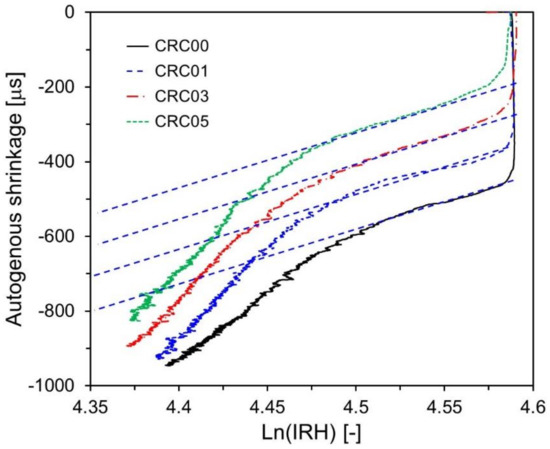
Figure 13.
The relationship between autogenous shrinkage and IRH.
3.4. Thermogravimetric Analysis
Figure 14 shows TG analysis results. As the CNT content increased, the weight change caused by TG also increased. This appears to be because the addition of CNTs accelerated early age hydration and thereby increased hydrates, as can be seen from Figure 7 and Figure 8. In the graph, the weight began to change after 50 °C, and the weight change increased as the CNT content increased. The decomposition of C-S-H, a main hydrate of cement, occurs between 50 and 200 °C, and it appears that the generation of C-S-H was accelerated. Portlandite, another main hydrate of OPC, decomposes between 400 and 580 °C. As its contents were 13.05, 12.30, 12.00, and 12.11% in CRC00, CRC01, CRC03, and CRC05, respectively, the effect of CNT addition on it was found to be insignificant. Jung et al. [57] also reported that decomposition increased at temperatures below 200 °C as the addition of CNT increased. CNTs accelerate the early age hydration of OPC, but they appear not to have an impact large enough to rapidly increase hydration products.
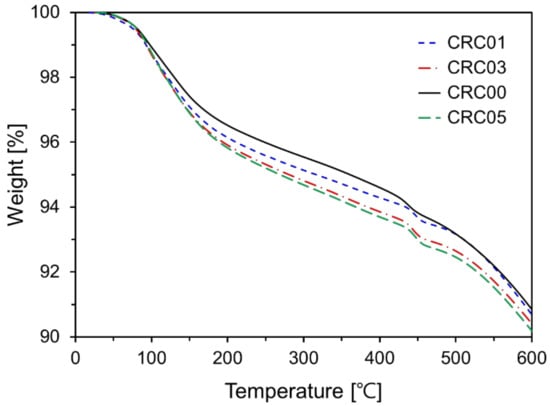
Figure 14.
TG analysis results.
4. Conclusions
In this study, the effects of carbon nanotubes (CNTs) on the hydration and autogenous shrinkage of cementitious materials were investigated. In the experiments, ordinary Portland cement (OPC) and fly ash (FA) were used as binders, and CNT-reinforced cement composites fabricated with different CNT contents were used. The experimental results are summarized as follows:
- CNTs accelerate the hydration of cementitious materials. As the CNT content increased, the induction period decreased, thereby increasing the hydration rate. The cumulative heat release of CRC00 measured for 48 h, however, was identical to that of CRC01 and its difference from those of CRC03 and CRC05 decreased, thereby showing that the long-term effect of CNTs on hydration was insignificant.
- The compressive strength was greatest when the CNT content was 0.1%, but it decreased as the CNT content was further increased. This appears to be due to the agglomerated CNTs inside the cement composites. Therefore, a method for dispersing CNTs is required to use more than 0.1% of CNTs,
- Unlike previous studies, the autogenous shrinkage of the cement composites decreased as the CNT content increased in this study. This result indicated that the bridge effect of CNTs decreased autogenous shrinkage even though hydration was accelerated by CNTs.
- The internal relative humidity (IRH) decreased as the CNT content increased. This is because CNTs accelerate hydration and thereby rapidly consume water inside the pores. The difference in IRH depending on the CNT content, however, decreased over time.
- When the correlation between IRH and autogenous shrinkage was analyzed, it was found that the effect of the IRH reduction on autogenous shrinkage was not significant. This is because the reduction in autogenous shrinkage was due to the decrease in bulk strain caused by the bridge effect of the CNTs.
- Autogenous shrinkage decreased because the bulk strain of cementitious materials decreased by the bridge effect of CNTs even though the hydration accelerated by the addition of CNTs.
Author Contributions
Formal analysis, investigation, resources, data curation, writing—original draft preparation, visualization, B.P.; Conceptualization, methodology, validation, supervision, project administration, funding acquisition, Y.C.C.; All authors have read and agreed to the published version of the manuscript.
Funding
This work was supported by the Korea Institute of Energy Technology Evaluation and Planning (KETEP) and the Ministry of Trade, Industry & Energy (MOTIE) of the Republic of Korea (No. 20181110200070). This work was also supported by the Gachon University research fund of 2020. (GCU-202003060001).
Institutional Review Board Statement
Not applicable.
Informed Consent Statement
Not applicable.
Data Availability Statement
Data sharing not applicable.
Conflicts of Interest
The authors declare no conflict of interest. The funders had no role in the design of the study; in the collection, analyses, or interpretation of data; in the writing of the manuscript, or in the decision to publish the results.
References
- Tanaka, K.; Sato, T.; Yamabe, T.; Okahara, K.; Uchida, K.; Yumura, M.; Niino, H.; Ohshima, S.; Kuriki, Y.; Yase, K.; et al. Electronic properties of carbon nanotube. Chem. Phys. Lett. 1994, 223, 65–68. [Google Scholar] [CrossRef]
- Salvetat, J.P.; Bonard, J.M.; Thomson, N.H.; Kulik, A.J.; Forr, L.; Benoit, W.; Zuppiroli, L. Mechanical properties of carbon nanotubes. Appl. Phys. A 1999, 69, 255–260. [Google Scholar] [CrossRef]
- Ruoff, R.S.; Lorents, D.C. Mechanical and thermal properties of carbon nanotubes. Carbon 1995, 33, 925–930. [Google Scholar] [CrossRef]
- Nam, I.W.; Kim, H.K.; Lee, H.K. Influence of silica fume additions on electromagnetic interference shielding effectiveness of multi-walled carbon nanotube/cement composites. Constr. Build. Mater. 2012, 30, 480–487. [Google Scholar] [CrossRef]
- Kim, H.K.; Nam, I.W.; Lee, H.K. Enhanced effect of carbon nanotube on mechanical and electrical properties of cement composites by incorporation of silica fume. Compos. Struct. 2014, 107, 60–69. [Google Scholar] [CrossRef]
- Yu, X.; Kwon, E. A carbon nanotube/cement composite with piezoresistive properties. Smart Mater. Struct. 2009, 18, 055010. [Google Scholar] [CrossRef]
- Sobolkina, A.; Mechtcherine, V.; Khavrus, V.; Maier, D.; Mende, M.; Ritschel, M.; Leonhardt, A. Dispersion of carbon nanotubes and its influence on the mechanical properties of the cement matrix. Cem. Concr. Compos. 2012, 34, 1104–1113. [Google Scholar] [CrossRef]
- Balasubramaniam, B.; Mondal, K.; Ramasamy, K.; Palani, G.S.; Iyer, N.R. Hydration phenomena of functionalized carbon nanotubes (CNT)/cement composites. Fibers 2017, 5, 39. [Google Scholar] [CrossRef]
- Cui, X.; Han, B.; Zheng, Q.; Yu, X.; Dong, S.; Zhang, L.; Ou, J. Mechanical properties and reinforcing mechanisms of cementitious composites with different types of multiwalled carbon nanotubes. Compos. Part A 2017, 103, 131–147. [Google Scholar] [CrossRef]
- Zhu, X.; Gao, Y.; Dai, Z.; Corr, D.J.; Shah, S.P. Effect of interfacial transition zone on the Young’s modulus of carbon nanofiber reinforced cement concrete. Cem. Concr. Res. 2018, 107, 49–63. [Google Scholar] [CrossRef]
- Metaxa, Z.S.; Tolkou, A.K.; Efstathiou, S.; Rahdar, A.; Favvas, E.P.; Mitropoulos, A.C.; Kyzas, G.Z. Nanomaterials in cementitious composites: An update. Molecules 2021, 26, 1430. [Google Scholar] [CrossRef]
- Konsta-Gdoutos, M.S.; Aza, C.A. Self sensing carbon nanotube (CNT) and nanofiber (CNF) cementitious composites for real time damage assessment in smart structures. Cem. Concr. Compos. 2014, 53, 162–169. [Google Scholar] [CrossRef]
- Materazzi, A.L.; Ubertini, F.; D’Alessandro, A. Carbon nanotube cement-based transducers for dynamic sensing of strain. Cem. Concr. Compos. 2013, 37, 2–11. [Google Scholar] [CrossRef]
- Zhang, W.; Zheng, Q.; Wang, D.; Yu, X.; Han, B. Electromagnetic properties and mechanisms of multiwalled carbon nanotubes modified cementitious composites. Constr. Build. Mater. 2019, 208, 427–443. [Google Scholar] [CrossRef]
- Han, B.; Yu, X.; Ou, J. Nanotechnology in Civil Infrastructure, 1st ed.; Springer: Berlin Heidelberg, Germany, 2011; pp. 1–47. [Google Scholar] [CrossRef]
- Lee, H.; Yu, W.; Chung, W. Damage detection of carbon nanotube cementitious composites using thermal and electrical resistance properties. Appl. Sci. 2021, 11, 2955. [Google Scholar] [CrossRef]
- Tragazikis, I.K.; Kordatou, T.Z.; Exarchos, D.A.; Dalla, P.T.; Matikas, T.E. Monitoring the hydration process in carbon nanotube reinforced cement-based composites using nonlinear elastic waves. Appl. Sci. 2021, 11, 1720. [Google Scholar] [CrossRef]
- Makar, J.M.; Chan, G.W. Growth of cement hydration products on single-walled carbon nanotubes. J. Am. Ceram. Soc. 2009, 92, 1303–1310. [Google Scholar] [CrossRef]
- Petrunin, S.; Vaganov, V.; Reshetniak, V.; Zakrevskaya, L. Influence of carbon nanotubes on the structure formation of cement matrix. IOP Conf. Ser. Mater. Sci. Eng. 2015, 96, 012046. [Google Scholar] [CrossRef]
- Yamamoto, G.; Shirasu, K.; Hashida, T.; Takagi, T.; Suk, J.W.; An, J.; Piner, R.D.; Ruoff, R.S. Nanotube fracture during the failure of carbon nanotube/alumina composites. Carbon 2011, 49, 3709–3716. [Google Scholar] [CrossRef]
- Konsta-Gdoutos, M.S.; Metaxa, Z.S.; Shah, S.P. Highly dispersed carbon nanotube reinforced cement based materials. Cem. Concr. Res. 2010, 40, 1052–1059. [Google Scholar] [CrossRef]
- Raza, A.; Bhandari, M.; Kim, H.K.; Son, H.M.; Huang, B.; Nam, I.W. A study on mechanical characteristics of cement composites fabricated with nano-silica and carbon nanotube. Appl. Sci. 2021, 11, 152. [Google Scholar] [CrossRef]
- Kim, G.M.; Yang, B.J.; Cho, K.J.; Kim, E.M.; Lee, H.K. Influences of CNT dispersion and pore characteristics on the electrical performance of cementitious composites. Compos. Struct. 2017, 164, 32–42. [Google Scholar] [CrossRef]
- Kim, H.K.; Park, I.S.; Lee, H.K. Improved piezoresistive sensitivity and stability of CNT/cement mortar composites with low water-binder ratio. Compos. Struct. 2014, 116, 713–719. [Google Scholar] [CrossRef]
- Nochaiya, T.; Chaipanich, A. Behavior of multi-walled carbon nanotubes on the porosity and microstructure of cement-based materials. Appl. Surf. Sci. 2011, 257, 1941–1945. [Google Scholar] [CrossRef]
- Yang, Y.; Sato, R.; Kawai, K. Autogenous shrinkage of high-strength concrete containing silica fume under drying at early ages. Cem. Concr. Res. 2005, 35, 449–456. [Google Scholar] [CrossRef]
- Tazawa, E. Autogenous Shrinkage of Concrete, 1st ed.; CRC Press: London, UK, 1999. [Google Scholar]
- Stynoski, P.; Mondal, P.; Marsh, C. Effects of silica additives on fracture properties of carbon nanotube and carbon fiber reinforced Portland cement mortar. Cem. Concr. Compos. 2015, 55, 232–240. [Google Scholar] [CrossRef]
- Hawreen, A.; Bogas, J.A.; Dias, A.P.S. On the mechanical and shrinkage behavior of cement mortars reinforced with carbon nanotubes. Constr. Build. Mater. 2018, 168, 459–470. [Google Scholar] [CrossRef]
- Morsy, M.S.; Alsayed, S.H.; Aqel, M. Hybrid effect of carbon nanotube and nano-clay on physico-mechanical properties of cement mortar. Constr. Build. Mater. 2011, 25, 145–149. [Google Scholar] [CrossRef]
- Liu, X.; Fang, T.; Zuo, J. Effect of nano-materials on autogenous shrinkage properties of cement based materials. Symmetry 2019, 11, 1144. [Google Scholar] [CrossRef]
- Collins, F.; Lambert, J.; Duan, W.H. The influences of admixtures on the dispersion, workability, and strength of carbon nanotube-OPC paste mixtures. Cem. Concr. Compos. 2012, 34, 201–207. [Google Scholar] [CrossRef]
- Bom, D.; Andrews, R.; Jacques, D.; Anthony, J.; Chen, B.; Meier, M.S.; Selegue, J.P. Thermogravimetric analysis of the oxidation of multiwalled carbon nanotubes: Evidence for the role of defect sites in carbon nanotube chemistry. Nano. Lett. 2002, 2, 615–619. [Google Scholar] [CrossRef]
- Kitiyanan, B.; Alvarez, W.E.; Harwell, J.H.; Resasco, D.E. Controlled production of single-wall carbon nanotubes by catalytic decomposition of CO on bimetallic Co–Mo catalysts. Chem. Phys. Lett. 2000, 317, 497–503. [Google Scholar] [CrossRef]
- Tang, S.; Zhong, Z.; Xiong, Z.; Sun, L.; Liu, L.; Lin, J.; Shen, Z.X.; Tan, K.L. Controlled growth of single-walled carbon nanotubes by catalytic decomposition of CH4 over Mo/Co/MgO catalysts. Chem. Phys. Lett. 2001, 350, 19–26. [Google Scholar] [CrossRef]
- Han, B.; Yu, X.; Ou, J. Effect of water content on the piezoresistivity of MWNT/cement composites. J. Mater. Sci. 2010, 45, 3714–3719. [Google Scholar] [CrossRef]
- Chaipanich, A.; Nochaiya, T.; Wongkeo, W.; Torkittikul, P. Compressive strength and microstructure of carbon nanotubes-fly ash cement composites. Mater. Sci Eng. A 2010, 527, 1063–1067. [Google Scholar] [CrossRef]
- Wang, Q.; Cui, X.; Wang, J.; Li, S.; Lv, C. Dong, Y. Effect of fly ash on rheological properties of graphene oxide cement paste. Constr. Build. Mater. 2017, 138, 35–44. [Google Scholar] [CrossRef]
- ASTM International. NoC191-19 Standard Test Methods for Time of Setting of Hydraulic Cement by Vicat Needle; ASTM International: West Conshohocken, PA, USA, 2019. [Google Scholar] [CrossRef]
- ISO 679. Cement-Test Methods-Determination of Strength; ISO: Geneva, Switzerland, 2009. [Google Scholar]
- Park, B.; Choi, Y.C. Prediction of self-healing potential of cementitious materials incorporating crystalline admixture by isothermal calorimetry. Int. J. Concr. Struct. Mater. 2019, 13, 629–642. [Google Scholar] [CrossRef]
- Kohno, K.; Okamoto, T.; Isikawa, Y.; Sibata, T.; Mori, H. Effects of artificial lightweight aggregate on autogenous shrinkage of concrete. Cem. Concr. Res. 1999, 29, 611–614. [Google Scholar] [CrossRef]
- Kim, J.H.; Choi, S.W.; Lee, K.M.; Choi, Y.C. Influence of internal curing on the pore size distribution of high strength concrete. Constr. Build. Mater. 2018, 192, 50–57. [Google Scholar] [CrossRef]
- Park, B.; Choi, Y.C. Self-healing capability of cementitious materials with crystalline admixtures and super absorbent polymers (SAPs). Constr. Build. Mater. 2018, 189, 1054–1066. [Google Scholar] [CrossRef]
- Jansen, D.; Goetz-Neunhoeffer, F.; Lothenbach, B.; Neubauer, J. The early hydration of Ordinary Portland Cement (OPC): An approach comparing measured heat flow with calculated heat flow from QXRD. Cem. Concr. Res. 2012, 42, 134–138. [Google Scholar] [CrossRef]
- Tafesse, M.; Kim, H.K. The role of carbon nanotube on hydration kinetics and shrinkage of cement composite. Compos. Part B Eng 2019, 169, 55–64. [Google Scholar] [CrossRef]
- Jung, M.; Lee, Y.S.; Hong, S.G.; Moon, J. Carbon nanotubes (CNTs) in ultra-high performance concrete (UHPC): Dispersion, mechanical properties, and electromagnetic interference (EMI) shielding effectiveness (SE). Cem. Concr. Res. 2020, 131, 106017. [Google Scholar] [CrossRef]
- Guan, X.; Bai, S.; Li, H.; Ou, J. Mechanical properties and microstructure of multi-walled carbon nanotube-reinforced cementitious composites under the early-age freezing conditions. Constr. Build. Mater. 2020, 233, 117317. [Google Scholar] [CrossRef]
- Liu, K.; Yu, R.; Shui, Z.; Yi, S.; Li, X.; Ling, G.; He, Y. Influence of external water introduced by coral sand on autogenous shrinkage and microstructure development of Ultra-High Strength Concrete (UHSC). Constr. Build. Mater. 2020, 252, 119111. [Google Scholar] [CrossRef]
- Valipour, M.; Khayat, K.H. Coupled effect of shrinkage-mitigating admixtures and saturated lightweight sand on shrinkage of UHPC for overlay applications. Constr. Build. Mater. 2018, 184, 320–329. [Google Scholar] [CrossRef]
- Cusson, D.; Hoogeveen, T. Internal curing of high-performance concrete with pre-soaked fine lightweight aggregate for prevention of autogenous shrinkage cracking. Cem. Concr. Res. 2008, 38, 757–765. [Google Scholar] [CrossRef]
- Yang, F.; Qian, S. Mechanical and piezoelectric properties of ECC with CNT incorporated through fiber modification. Constr. Build. Mater. 2020, 260, 119717. [Google Scholar] [CrossRef]
- Kim, G.M.; Yoon, H.N.; Lee, H.K. Autogenous shrinkage and electrical characteristics of cement pastes and mortars with carbon nanotube and carbon fiber. Constr. Build. Mater. 2018, 177, 428–435. [Google Scholar] [CrossRef]
- Song, C.; Hong, G.; Choi, S. Effect of dispersibility of carbon nanotubes by silica fume on material properties of cement mortars: Hydration, pore structure, mechanical properties, self-desiccation, and autogenous shrinkage. Constr. Build. Mater. 2020, 265. [Google Scholar] [CrossRef]
- Zhang, J.; Han, Y.D.; Gao, Y.; Luosun, Y. Integrative study on the effect of internal curing on autogenous and drying shrinkage of high-strength concrete. Dry. Technol. 2013, 31, 565–575. [Google Scholar] [CrossRef]
- Han, Y.; Zhang, J.; Luosun, Y.; Hao, T. Effect of internal curing on internal relative humidity and shrinkage of high strength concrete slabs. Constr. Build. Mater. 2014, 61, 41–49. [Google Scholar] [CrossRef]
- Jung, S.H.; Oh, S.; Kim, S.W.; Moon, J.H. Effects of CNT dosages in cement composites on the mechanical properties and hydration reaction with low water-to-binder ratio. Appl. Sci. 2019, 9, 4630. [Google Scholar] [CrossRef]
Publisher’s Note: MDPI stays neutral with regard to jurisdictional claims in published maps and institutional affiliations. |
© 2021 by the authors. Licensee MDPI, Basel, Switzerland. This article is an open access article distributed under the terms and conditions of the Creative Commons Attribution (CC BY) license (https://creativecommons.org/licenses/by/4.0/).